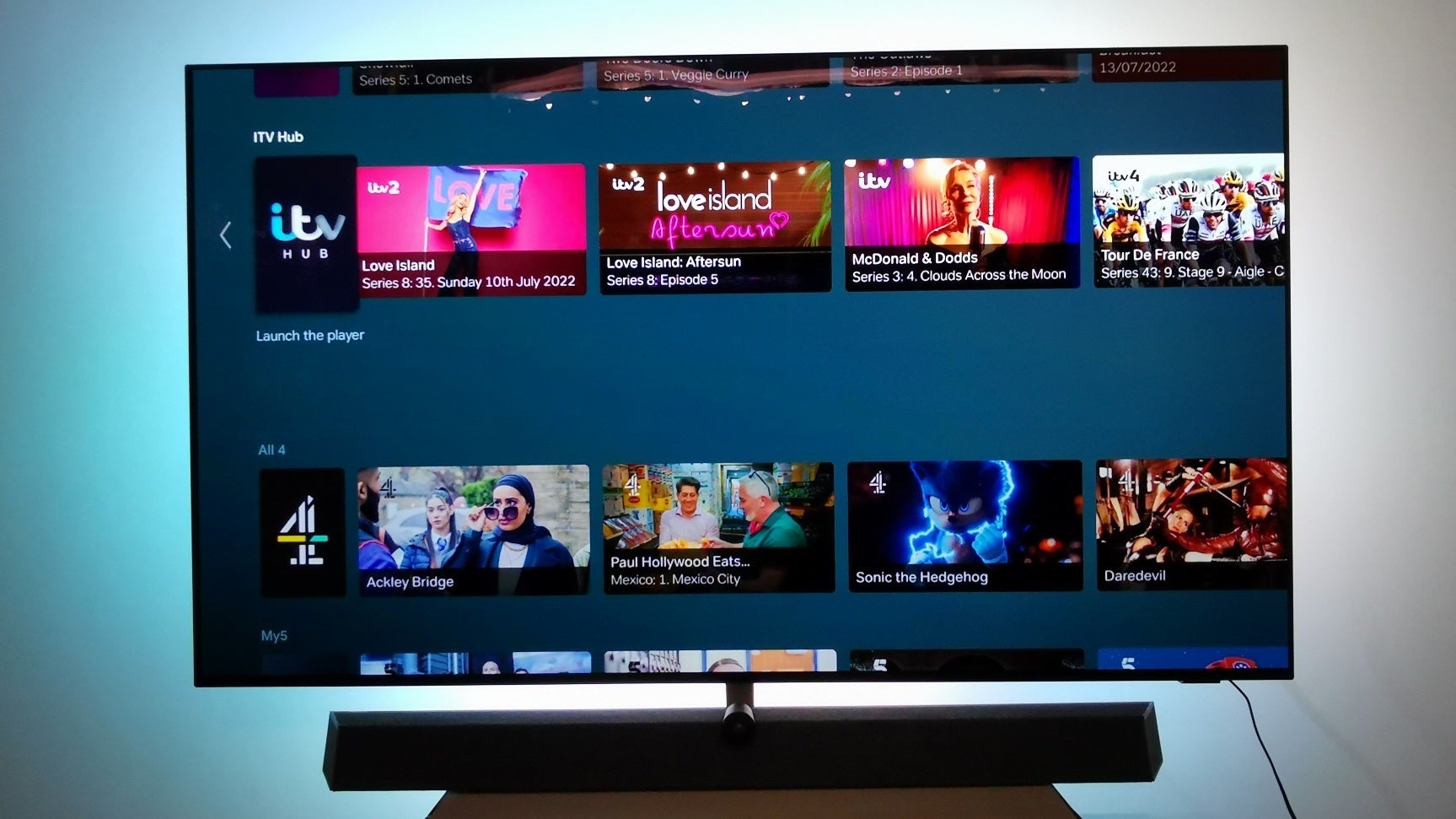Verdict
The adoption of a new OLED EX panel has allowed Philips to boost overall brightness levels to a point where this OLED screen can rival bright LED TVs for dynamic daytime viewing. The built-in Bowers & Wilkins sound system is one of the best we’ve heard to date, too! Gamers will appreciate support for 4K 120fps playback, but this is still fundamentally a cinema screen at heart – and a formidable one at that!
Pros
- High HDR peak brightness
- 95W Bowers & Wilkins Dolby Atmos sound system
- Universal HDR support (Dolby Vision, HDR10+, HLG)
- Game Bar interface
Cons
- Only two HDMI inputs support 4K/120 fps
- More expensive than most
-
HDRDolby Vision, HDR10, HDR10+ Adaptive, HLG, HGiG -
Bias lightingNext Generation Ambilight -
Processor6th Gen P5 AI Intelligent Dual Engine
Introduction
Philips revamps its flagship OLED model using the latest high brightness OLED panel technology and a completely re-engineered Bowers & Wilkins sound system, and the result is stunning.
This 65-incher is a thoroughbred performer, boasting beautiful picture quality, with a variety of crowd pleasing presets, plus top notch audio. Even Ambilight gets an effective upgrade…
Availability
- UKRRP: £3000
- USAunavailable
- EuropeTBC
- Canadaunavailable
The OLED+937 is available in two sizes, 65- and 77-inches. It’s positioned at the top of the food chain, with an expected launch price of £3,000. There’s no price on the 77-inch, however LG charges £4,000 for its comparable Gallery G2, so let’s assume it’s a little north of that for the time being…
Expect the 65-inch model to launch mid-October, with the larger set to follow…
Design
- Fully-integrated Bowers & Wilkins sound system
- Next Generation Ambilight
- Ultra-thin panel and bezel
The 65OLED937 is not a screen to blend into the background. The panel is essentially sans bezel, with a dramatic looking Bowers & Wilkins sound system fully integrated. This speaker forms part of the pedestal foot, and connects via a captive lead, so the two can’t be separated.
The bar sports B&W’s trademark tweeter-on-top design, wrapped in grey Kvadrat fabric. The side facing drivers are sharply angled for maximum wraparound effect, while upfiring drivers handle the height channel.
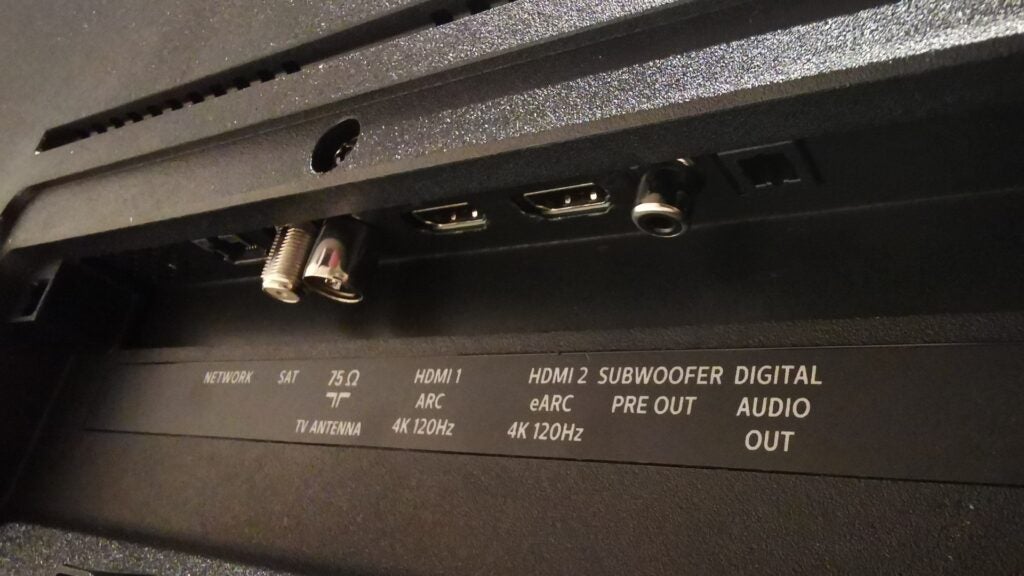
The set has four HDMI inputs, but only two (HDMI 1 and 2) are v2.1 and support 4K/120fps sources. All four inputs are ARC compatible, with HDMI 2 eARC enabled. There’s also a trio of USB inputs, a digital audio output and Ethernet to support Wi-Fi.
The TV ships with a slim, silver backlit remote control, featuring dedicated buttons for Netflix, Rakuten TV and Prime Video.
Features
- New Game bar customisation
- Android TV OS
- Aurora Ambilight mode
Arguably the biggest feature update on the OLED+937 is the revamped Ambilight. Presented here in a four-sided configuration, all LEDs are now driven individually, thanks to a newly developed driver IC (previously, they were driven in colour groups of three).
The result is rather more precision when it comes to casting colours onto your wall. I’m told in the final release version of the firmware there will also be a ‘Classic Ambilight’ switch if this new iteration looks too fancy.
New for 2022 is Aurora, a gallery of images and scenes that combine with Ambilight to create a novel room ambience. Accessed in the set’s menu, visuals are limited at launch but the concept clearly has legs.
As seen before, there’s also compatibility with Philips Hue smart lighting system, as well as the brand’s Ambilight-equipped wireless home speakers (which were not supplied for review).
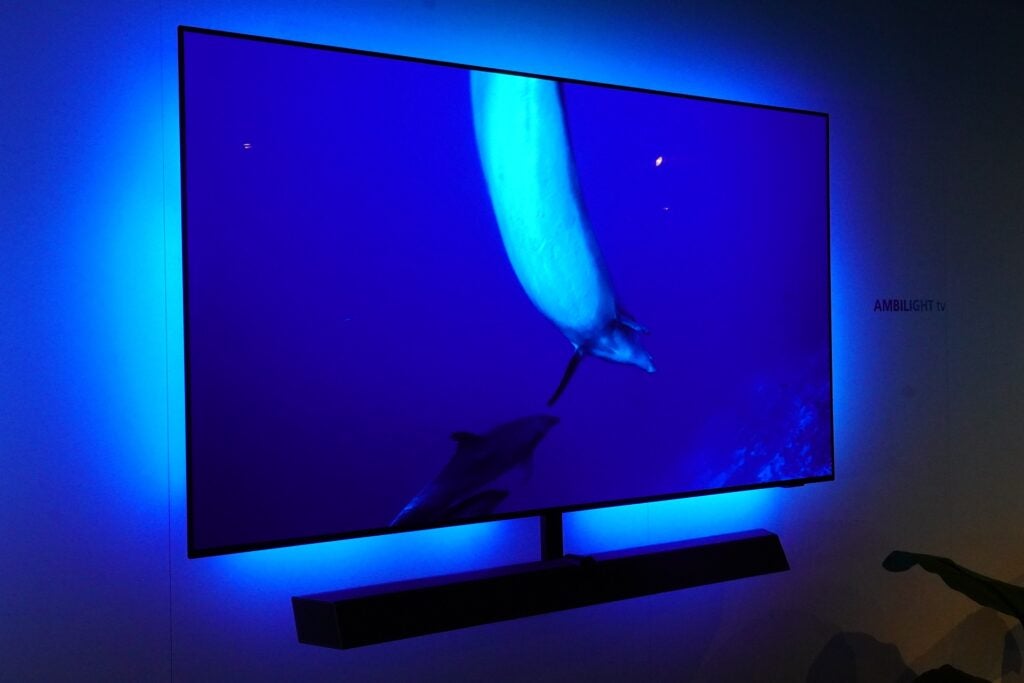
Philips is upping its game on the OLED937, with Game Bar. This is activated by a long press on the menu button, and allows gamers to make specific adjustments mid-game. With Game Bar you can optimise settings for different gameplay and enable VRR, AMD FreeSync or NVidia G-Sync.
Dig around the game settings and you’ll also find a VRR Shadow enhancer, to preserve low level detail at higher refresh rates.
It’s worth noting that the set only supports 4K/120fps with half vertical resolution, apparently a consequence of the twin chip solution used for its picture engine. For 4K/120fps with VRR you’ll need to use the TV in its Monitor mode. I measured input lag at 21.5ms in Game mode (1080/60), which is a tad below average.
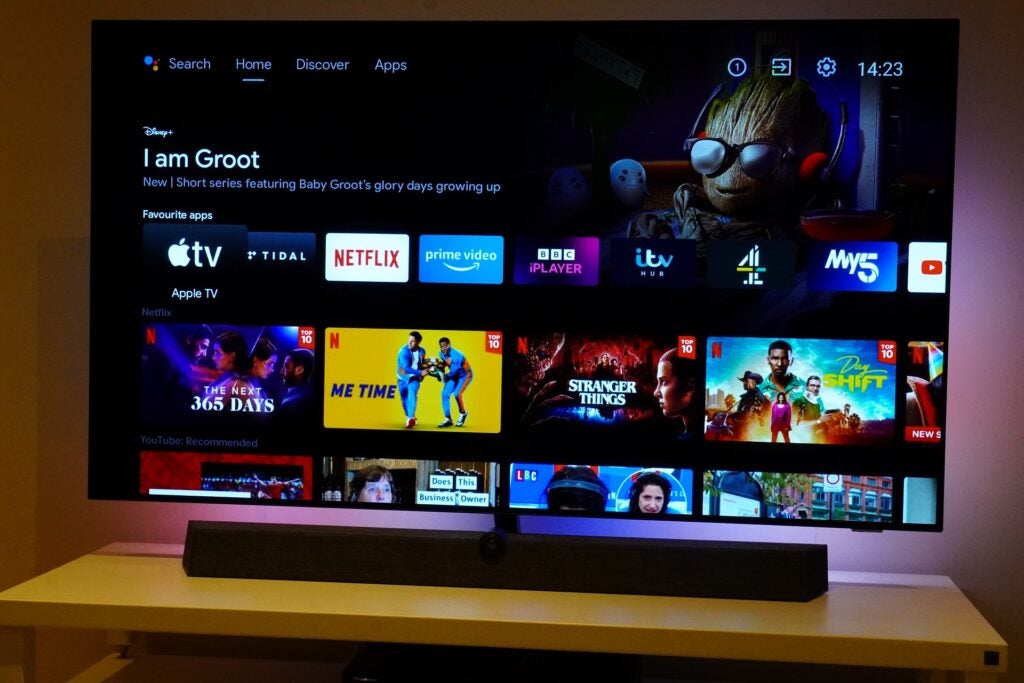
The smart platform of choice remains Android, which offers a full range of streaming services, including Netflix, Prime Video, and Disney+. It’s partnered in the UK with a Freeview Play terrestrial tuner, so all mainstream catch-up TV services are also covered.
Picture Quality
- Highly dynamic OLED display
- Impressive Dolby Atmos audio system
- 6th gen P5 AI Intelligent Dual Engine
Straight from the box, the OLED937 knows how to wow. The latest iteration of Philips P5 picture engine finds a perfect partner in this 2022 OLED EX panel, and the brand doesn’t shy away from candy colours and punchy dynamics, both of which are in plentiful supply here.
The set is an easy one to live with. Ambient Intelligence Picture Processing, first introduced on the OLED+936, allows the P5 AI Dual Picture processor to automatically adjust the brightness, gamma and colour of the screen, depending on the ambient lighting conditions.
All you need to do is select from one of three AI options: Eye Care, Dark Detail optimization and Colour Temperature optimisation.
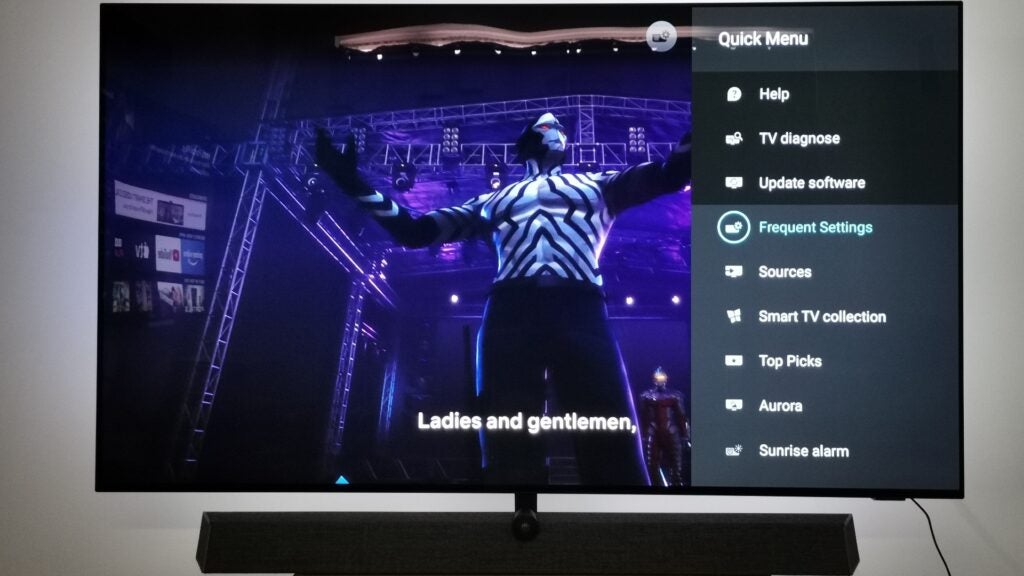
The most interesting option is Dark Detail Optimisation, which automatically lowers the gamma in a bright room, to better reveal near shadow detail. In well lit rooms gamma 2.0 is selected automatically, but this switches to gamma 2.4 when watching in a dark room, and Ambilight is turned off.
Alternatively, Eye Care uses the set’s light sensor to lower the intensity of peak HDR highlights when viewed in a dark room, and boosts them when the light sensor detects that the TV is in a brightly lit room.
Picture presets comprise Personal, Crystal Clear, Home Cinema, Eco, Filmmaker Mode, and Expert 1 and 2; there’s also a Calman calibration setting. View HDR content and you’ll get appropriate HDR image presets: HDR Personal, HDR Crystal Clear, HDR Home Cinema, HDR Filmmaker Mode, HDR IMAX Enhanced, HDR Game and HDR Monitor.
Crystal Clear is the new name for Vivid. Believe it or not, I actually found this fine for casual daytime viewing, precisely because it has so much inherent pop. Brightly lit studio shows and news benefit from its visual boldness. Crystal Clear has Philips Light Boost setting at Max by default, and it’s dramatic.
Light Boost automatically adjusts the contrast level of the picture. In its Max guise it adds a startling lift which can seem overwrought. If you prefer a constant level of luminance and contrast, the processing can be switched off, but I found Light Boost almost always beneficial when parked on Medium.
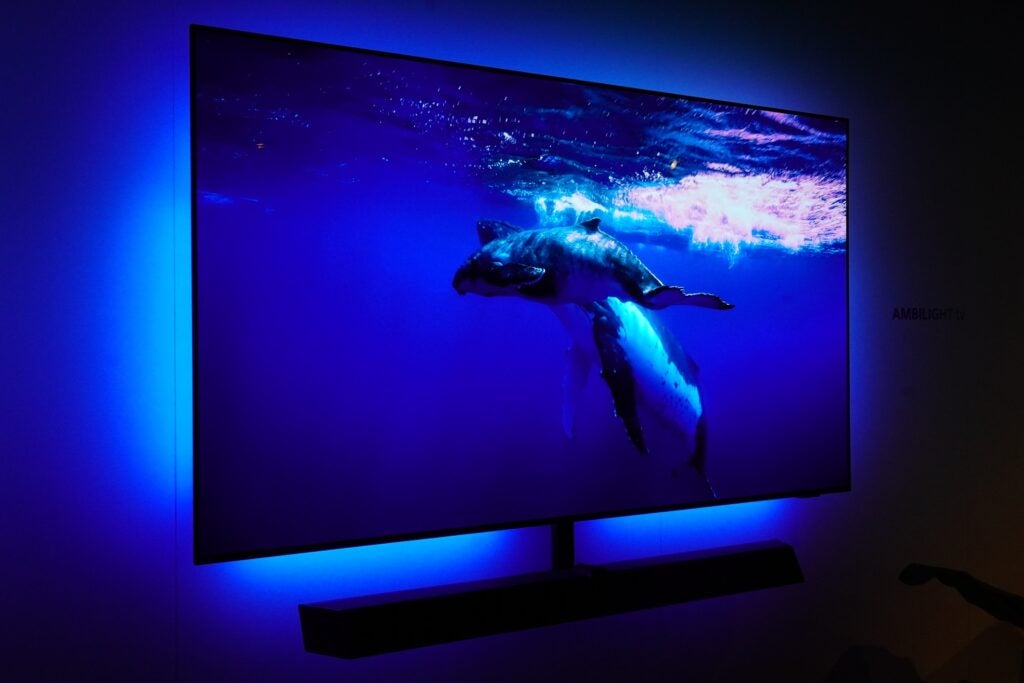
You still get blistering detail, courtesy of the set’s Ultra Resolution processing, which can be unflattering with studio close-ups; switching off Ultra Resolution robs static items (like the mic in a studio setting) of fine (interpolated?) detail.
Replacing Standard as the all-purpose default is Eco. This is generally a good viewing option if you can’t be bothered to fine tune the Personal option. That said, Home Cinema remains the best movie watching mode, having more obvious visual appeal than Filmmaker mode.
The OLED937’s HDR performance can be considered excellent, thanks to a killer combo of aggressive Philips processing, that new OLED EX panel and its physical heatsink. The system is really good at delivering small HDR highlights, like glinting headlights and fireworks. It doesn’t hold onto these peaks for long though, they’re quick to dim.
HDR highlights typically come in at around 1000 nits, glowing brighter the smaller and more intense their application. Set to Personal mode, I measured the set at 905 nits.
Sound Quality
- Dolby Atmos sound system
- DTS-Play Fi compatibility
Sonically, the OLED937 is a winner. Bowers & Wilkins has made some big upgrades on this model, and they pay dividends.
The set offers excellent dialogue clarity, thanks to a 19mm titanium tweeter, and bass depth is prodigious.
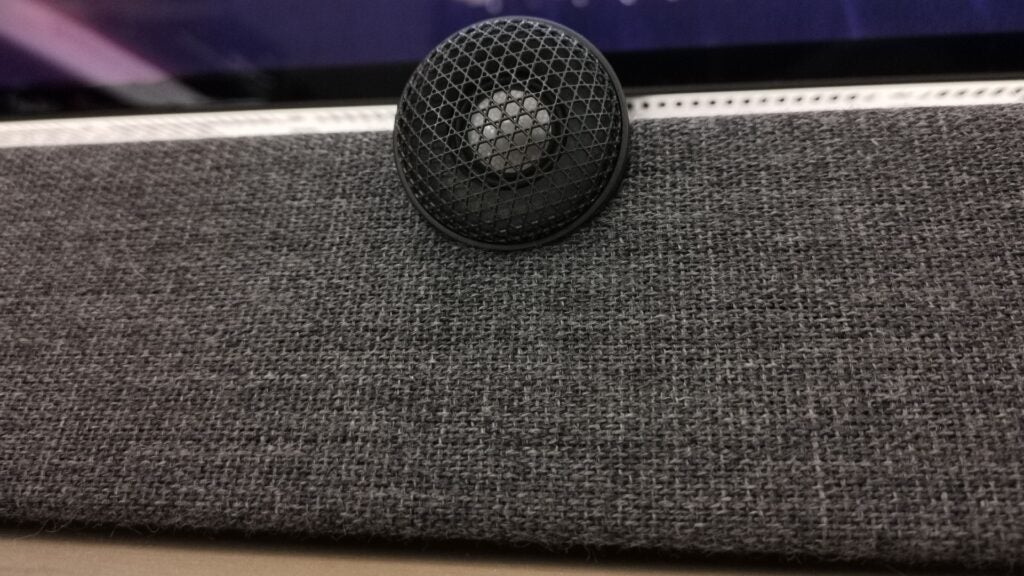
Overall, the presentation is impressively high and wide, and there’s a pronounced sense of movement about the soundstage. I didn’t detect anything to the rear, but that’s to be expected, the system certainly sounds theatrical.
The sound system is also compatible with DTS Play-Fi. Useful if you have any additional Play-Fi enabled speakers around the house.
Latest deals
Should you buy it?
You want a high performance all-in-one home cinema solution The OLED937 is capable of superb 4K picture quality, with punchy dynamics and vibrant hues, and boasts an outstanding Bowers & Wilkins designed Dolby Atmos sound system.
You already have a home theatre sound system The Bowers & Wilkins built-in sound system is one of the best we’ve heard on a 4K flatscreen, but it doesn’t offer immersive surround sound like a dedicated AV receiver system.
Final Thoughts
The 65OLED937 is a hugely impressive OLED flagship TV, one that pushes the envelope when it comes to both performance and features. Visually it’s a knockout. Philips new AI Dual Engine processor and OLED EX panel with brightness boosting heatsink prove to be a formidable combo. Its HDR handling is highly dynamic.
The integrated Dolby Atmos soundbar is also a big step forward from Bowers & Wilkins, and can be considered more powerful and immersive than its predecessor.
The OLED937 wouldn’t be our first choice when it comes to high-end gaming all things considered, but it’s a strong alternative to Panasonic’s LZ2000 range topper, and also boasts Next Gen Ambilight as well as a solid smart platform in Android 11.
How we test
We test every televisions we review thoroughly over an extended period of time. We use industry standard tests to compare features properly. We’ll always tell you what we find. We never, ever, accept money to review a product.
Find out more about how we test in our ethics policy.
Tested for more than week
Tested with real world use
FAQs
The OLED+937 only comes in two sizes: 65- and 77-inch models. The size of the sound system is the same irrespective of the screen size.
Sustainability
Trusted Reviews’ holds the fact that global warming is not a myth as a core value and will continuously endeavour to help protect our planet from harm in its business practices.
As part of this mission, whenever we review a product we send the company a series of questions to help us gauge and make transparent the impact the device has on the environment.
We currently haven’t received answers to the questions on this product, but will update this page the moment we do. You can see a detailed breakdown of the questions we ask and why in our sustainability info page.
Jargon buster
Dolby Atmos
Dolby Atmos is an object-based audio format. It expands on 5.1 and 7.1 soundtracks by adding overhead channels. Sounds are referred to as “audio objects”, of which there can be up to 128 audio channels, and these ‘objects’ can be accurately positioned within a 3D soundscape. This allows soundtracks that support the technology to place sounds above and around the listener with compatible kit.
OLED EX
OLED EX is a panel technology created by LG Display that uses a different material (deuterium) than older panels to help increase brightness
HDMI
HDMI stands for High Definition Multimedia Interface and is to transmit video/audio signals from a source to a receiver.



















